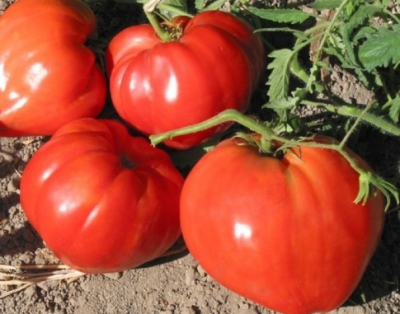
- Authors: Dederko V.N., Postnikova O.V.
- Year of approval: 2006
- Category: grade
- Growth type: determinant
- Appointment: fresh consumption, for pickling and canning, for juice, for ketchup and tomato paste
- Ripening period: mid-season
- Ripening time, days: 105-115
- Growing conditions: for open ground, for film greenhouses
- Marketability: high
- Transportability: high
The determinant non-standard universal variety Vechniy Zov is very popular. Tomato is grown in greenhouses and outdoors, used fresh, for cooking juices, sauces, tomato paste and salads - both summer and winter. The fruits have high marketable and transportable (in the brown stage) qualities.
Breeding history
Tomato Eternal Call was included in the State Register of the Russian Federation in 2006. The originators of the variety are the breeders V.N.Dederko and O.V. Postnikova.
Description of the variety
Low-growing semi-spreading non-standard bushes up to 70 cm high are covered with medium-sized dark green foliage. The variety gives up to 97% of the yield of marketable fruits, of which ripe up to 76%. Flowers of yellow color are collected in a simple inflorescence.
The Eternal Call variety has both positive qualities and disadvantages.
Advantages:
unpretentiousness;
large-fruited and pleasant taste;
the possibility of cultivation throughout the territory of Russia;
good productivity, marketability, rich vitamin composition.
Disadvantages:
impossibility of whole-fruit canning;
strange quality - tomatoes of the first harvest are the most delicious; by the end of the ripening period, the fruits lose their juiciness and sweetness.
In any case, practice has shown a clear preponderance of positive qualities, since the variety is very popular.
The main qualities of the fruit
Rounded medium-silvery fruits weighing from 110 to 500 g of green color with a dark spot at the stalk change color to dense crimson when ripe.
Taste characteristics
Sugar tender low-seeded tomato pulp is covered with a thin skin, which reduces the shelf life - no more than 45 days in a cool place.
Ripening and fruiting
Fruits of a mid-ripening variety begin to ripen 105-115 days from sowing.
Yield
Everlasting Call is marketed as a high-yielding variety, and years of practice have proven this. 3-4 kg are removed from the bush, from 1 sq. m - much more.
The timing of planting seedlings and planting in the ground
Seedling method of cultivation, the timing of sowing seeds falls on March-April. Ready seedlings are planted in a permanent place after 50-60 days.

Growing tomato seedlings is an extremely important process, because it largely depends on whether the gardener can harvest at all. All aspects must be taken into account, from seedbed preparation to planting in the ground.
Landing scheme
To obtain a good harvest and high quality fruits, it is necessary to observe not only the requirements of agricultural technology, but also the frequency of planting. No more than 3-4 plants are planted per square meter.

Growing and caring
One of the main features of the variety is its simplicity. Even a beginner in the garden business can grow the Eternal Call, which adds points to his popularity.It is grown in the traditional seedling method, the grown and hardened seedlings are transferred to a permanent place after 2 months. The soil should be fertile, breathable, with a pH level close to neutral. If the ground is highly acidic, this is not a problem. The soil is deoxidized with bone or dolomite flour, buckwheat or rice husks. In addition, the husk contains a large amount of vitamins, as well as trace elements necessary for the full development of plants:
potassium and phosphorus;
zinc, magnesium and iron.
Another important property of husks, which justifies the introduction of buckwheat husks into the soil, is the ability to attract earthworms with its aroma, taste and nutrients. And this is a clear increase in the humus content. For planting seedlings, the soil is prepared in advance, the husk is introduced during digging, just like humus. The soil taken out of the holes is enriched with mineral fertilizers and organic matter, if it has not been introduced in advance. A peg is installed in each hole for support, the roots of the seedling are spread, sprinkled with soil, then compacted and well spilled with warm water.
Care will consist in watering, loosening, weeding, forming a bush of 2-3 stems, pinching and feeding. Watering is carried out regularly during the period of growing green mass, flowering and ovary formation. Later, the amount of moisture is reduced, and during intensive ripening of the total mass of the crop, they stop altogether. As for the additional introduction of nutrients, the first feeding with nitrogen fertilizers is carried out two weeks after planting. During budding, the tomato needs potassium-phosphorus substances. In addition, tomatoes of any type respond gratefully to watering with mullein or nettle infusion.




A plant needs different micronutrients at each stage of growth. All fertilizers can be divided into two groups: mineral and organic. Folk remedies are often used: iodine, yeast, bird droppings, eggshells.
It is important to observe the rate and period of feeding. This also applies to folk remedies and organic fertilizers.
Disease and pest resistance
Despite the fact that the Eternal Call is resistant to diseases and successfully resists pests, preventive treatment with insecticides and fungicides is required.


Resistant to adverse weather conditions
Undemanding agrotechnical methods make the plant resistant to unfavorable growing conditions.
Growing regions
The variety is adapted for cultivation throughout Russia. These are the Northern and North-Western, Central regions, as well as the Volga-Vyatka, Central Black Earth Region, the North Caucasian, Middle Volga, Lower Volga, Ural, West Siberian, East Siberian, Far Eastern regions.

























































































